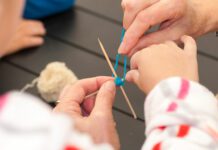Got a problem child? Good. Every teacher and children’s leader has one. It’s God’s gift to keep us humble. Troubled children create trouble. The question is how will you react and respond?
Misbehavior is the number one frustration in the classroom. When children act up or out, your defenses go on alert. Disruptive behavior runs the gamut from poking to punching, from whispering to whooping, from playfulness to punishable offenses. In a classroom or children’s ministry activity, kids will talk too loud and too much, grab things they shouldn’t and ignore things they should, and generally keep you on your toes (just to step on them). It’s nothing new. From the dawn of education, in some cave dedicated solely to learning stuff, little Bam Bam was breaking his teacher’s stone-age heart by being bad.
Kids will be kids.
At this point it’s easy to resign your fate to the problem child. Give in, let up, call off or sneak away saddled with “I’m not meant to teach kids” ringing in your psyche. Or, you can reward good behavior with food, toys and other treats in hopes of turning bad kids good. If you can’t beat them, bait them, right? Or, you can revenge misbehavior with punishment. Time outs. Loss of privileges. Loss of rewards. Yet, all these strategies are reactive in nature. Misbehavior happens and we respond in kind. But what if there’s a better way?
In my home I have several working smoke detectors. I also have a couple fire extinguishers. Both are useful for fire management. Smoke detectors are proactive in that they continually sniff the air for smoky odors. Often they beep without a fire present. But what do you do when a smoke detector beeps? I bet you don’t ignore it! My guess is you figure out the origination of the smoke problem. Sometimes it’s a legitimate fire and caught early no serious damage happens. Sometimes it’s merely smoke from Dad burning supper again.
Fire extinguishers are a more serious beast. These canisters filled with foam smother a fire and snuff it out. They’re only used when the fire is uncontrollable and the next step is a 911 call. Fire extinguishers are last resorts. They’re good to have in a pinch, but most homeowners would prefer they stay unused.
Smoke detectors sniff. Fire extinguishers snuff.
Proactive discipline sniffs. Reactive discipline snuffs.
In reality, most classroom management courses, seminars and workshops deal with fire extinguishers or what to do when there’s a problem. Unfortunately, a few of the strategies throw gas (not water) on the problem. The technique doesn’t exterminate the problem; it exasperates it!
It’s far better to know WHY kids misbehave. It’s better to build a smoke detector classroom that’s continually sniffing for misbehavior and correcting the friction before the heat and smoke become flame. Sniff or snuff, it’s your choice. It’s always your choice.
Ironically, biblical insight on discipline suggests a proactive perspective. We’ve all heard about the “rod” of discipline. Most teachers (and parents) view the rod as a punishing tool (and there are scriptures to back this idea up), but a rod was used primarily to count and correct. A rod separated sheep. A rod’s gentle rap let the sheep know of the shepherd’s presence. A rod guided and guarded. As the shepherd walked his flock, he used his rod as a moving fence to keep sheep in line. When one misbehaved, the beast got a gentle rap or guiding with the rod. Only if the sheep’s life were in danger would a beating come. It’s the reason David could sing in Psalm 23 that God’s “rod” is comfortable and soothing. The rod of discipline creates security. It’s a guide and guard, and if absolutely necessary a torture device. The rod corrects even the tiniest misbehavior. The goal is submission in order to move forward, grow or accomplish a task.
The problem in many Sunday school classrooms and children’s ministry events is the teachers and leaders resort to rods of punishment to stop misbehavior. We pull out the fire extinguisher and smother disruption. Such tactics do work, but they also create wet, irritated, frustrated and grumpy sheep. Punishment always answers the misdeed but rarely, if ever, does it address the reasons. It’s far better to sniff out misbehavior and correct it early, than to let behavior smolder, flame and burn before we act.
Why children misbehave is far more important! So why do they really act up? And what if our fire extinguisher strategies actually make the fire hotter? In reality, there are three simple reasons for misbehavior in all human beings, regardless of age. Learn them and you hold the key to proactive discipline.
BELONGING!
The first reason children misbehave relates to belonging issues. Psychologist Rudolf Dreikurs proposed every human being possesses a “genuine goal” to belong. In every social situation we seek to fit in, commune, and feel a part. After all, if we don’t belong, it’s so long. We check out—mentally, emotionally, spiritually and eventually physically.
Dreikurs theorized when humans don’t meet this goal to belong they pursue “mistaken goals” in order to feel the love. Each of these mistaken goals is like rungs on a ladder of misbehavior. The first rung is attention getting or innocuous, often overlooked whiffs of misbehavior. There’s friction and smoldering, but no fire yet. The second rung is power plays or attention-getting strategies! We have heat and clear smoke. The alarms are sounding, even though there’s still no flame. Revenge is the third rung. Now the power plays, if not resolved, turn personal. Fire is on the floor! Finally, if still no resolution to belonging happens, the person simply gives up. His/her attempts to belong were smothered by discipline strategies that fueled the flame.
These levels of misbehavior—attention seeking, power plays, revenge and resignation—were merely the ripples of the real reason: belonging. So let’s get practical. If a learner struggles to belong and tries to flag your attention through low-level misbehavior, how should you respond? Most classroom management courses and books suggest ignoring the behavior, but that’s a problem. Will ignoring low-level misbehavior help the child feel like they belong? Ignoring misbehavior only fuels it. So stop ignoring low-level misbehavior.
Power plays (and even revenge) are discouraging, but how do many teachers and leaders respond? In reality, we power play right back! We use strategies that embarrass (write names on the board), punish (loss of reward) and separate (time outs). And yet, do such power plays make the misbehaving learner feel more love or less? More like they belong or less like they belong? Now you see the problem.
Dreikurs’ theory revolutionized my classroom management schemes. I chose to sniff for belonging issues and then respond, as needed, to help children feel the love and belong. I reacted to attention-getting by proximity. I didn’t ignore. I got close. I appropriately touched the child. I called them by name. I gave them a responsibility or role. I snuffed out their belonging issues before they could heat into power plays. And frankly, I rarely see power plays anymore! When a child feels the love and fits in, they behave.












